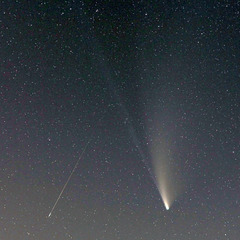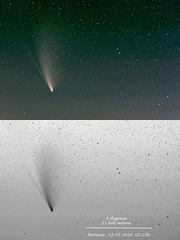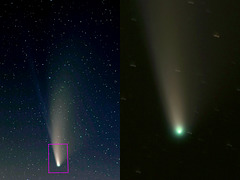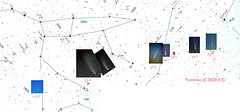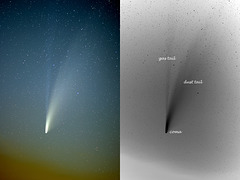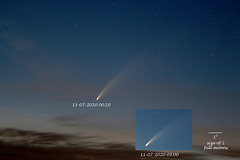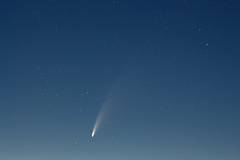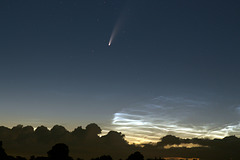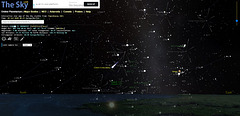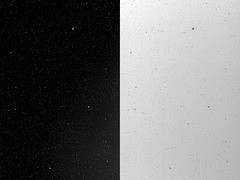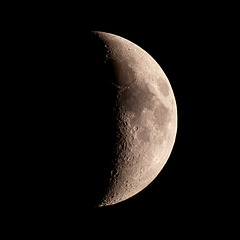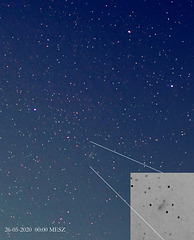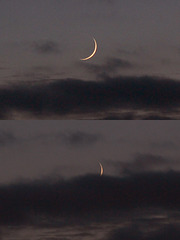
Astronomie
Folder: Astronomy
Comet Neowise (C/2020 F3) (view on black)
| |
|
|
|
I was lucky that I started early. It looked very promising but within half an hour heavy clouds made Neowise invisible.
Neowise is not visible with the naked eye anymore
Comet Neowise and a meteor
| |
|
|
|
22-07-2020 01:45h. For the sake of lowering noise I combined 5 exposures. The meteor was visible (obviously) on only one exposure of 30 sec..
Canon 700 D Sigma f=50mm, f/2,8, T=5x30 sec, ISO 800
Comet Neowise (C/2020 F3) (view on black)
| |
|
|
|
22-07-2020 02:15h
Canon 700D Sigma f=50 mm, f/2,8, T=50x30 sec, ISO 1600, cropped. The lower picure is a negative of the BW version of the upper picture. This brings out the details better.
Tomorow 23-07-2020 comet Neowise will be at its nearest distance to the earth
Comet Neowise (C/2020 F3) (view on black)
| |
|
|
|
21-07-2020 00:30h and 01:00h
Left: Canon 700D, Samyang f=85 mm, f/2.8, T=50x15 sec, ISO 800
Shows extend of gas and dust tail
Right: Canon 700D, Tamron f=200 mm, f/2.8. T=45x14 sec, ISO 800
area indicated in left picture
Shows greenish colour of the coma and the movement of the comet in 9 minutes
Neowise under the Big Dipper (view on black)
| |
|
|
|
21-07-2020 00:00h
A clear night was forecasted. Took the fotografic gear and off to the mill near Ter Apel. Neowise still easily visible by naked eye and easy to find.
Canon 700 D with Sigma DC 17-50: f=18mm, f/4 T=7x10 sec, ISO 800. Foreground is from one exposure.
Neowise
| |
|
|
|
From 11/7 until 22/7/2020 Neowise was visible by the naked eye, on 27/7 not anymore. (The PiP's show larger pictures). After that it's without binoculars not so easy. Photographically it is the comming days still "easy" to find. When you can clearly see the Big Dipper point your camera ~halfway between the Big Dipper and the horizon. Use a tripod, ISO 1600, f~50mm, f/2,8 and T> 1 sec, focus mannualy. Once you found the comet you can zoom in and choose better settings.
I want to thank everyone for the fine comments on the pictures of the comet and the many ******. For me, obviously, it was great to witness such a nice comet.
Comet Neowise (C/2020 F3) (view on black)
| |
|
|
|
17-07-2020 01:45h. First pictures on which the gas tail is clearly seen. The gas tail consists of ions of atoms and molecules, the dust tail of dust particles.
Samyang objective: f = 85 mm, f/1.4, T = 20 x 30 sec. ISO 800
Info: en.wikipedia.org/wiki/Comet
Comet Neowise (C/2020 F3)
| |
|
|
|
showing the movement of the comet. At the present distance Earth-comet the white bar (i.e one degree) is about 2,3 Milj km. This gives you an idea of the size of the tail and the distance the comet travels in this 46 hours.
Treat of the year: Neowise
Comet Neowise (C/2020 F3) (view on black)
| |
|
|
|
11-07-2020 3:00h
the tail is about 5 degrees in length (i.e. the moon on the sky is about 0,5 degrees)
Canon 700D with Samyang objective, f=85 mm f/2,8 T=31 x 4 sec ISO 400
Comet Neowise (C/2020 F3) (view on black)
| |
|
|
|
11-07-2020 2:45 h
Got up early and there he was, clearly visible by naked eye. This picture is a combination of 11 exposures.
Also visible some high clouds lit by the sun, noctilucent clouds.
Objective Samyang f=85 mm, f/2.8, T=11 x 2 sec ISO 800
To search for Neowise
| |
|
|
|
There is a planetarium program for the comet Neowise. The comming days it is in the same area as shown here, however the comet bcomes fainter. Best time is between 3 and 4 in the morning
theskylive.com/planetarium?objects=sun-moon-c2020f3-mercury-venus-mars-jupiter-saturn-uranus-neptune-pluto&localdata=53.07738%7C7.40444%7CPapenbourg+(DE)%7CEurope%2FBerlin%7C0&obj=c2020f3&h=02&m=05&date=2020-07-11#ra|6.246386079849314|dec|39.69035834673569|fov|50
NGC 3953 in Ursa Major
| |
|
|
|
The Iridium satellite is at a distance of ~780 km, the galaxy NGC 3953 is at about 56 miljon lightyears. (i.e. 56 x 1000000 x 300000 x365 x 24 x 60 x 60 = ...... km)
Canon 700 D in prime focus of a Newton Telescope, D=15 cm, f=750 mm T=20 x 30 sec, ISO 3200. The Iridium satellite was present in only one exposure
Die Galaxie M 109 in Ursa Major (view on black)
| |
|
|
|
Einer der schwächsten Objekte in der Liste von Messier (daher die M) .Im Jahre 1781 veröffentlichte er eine Liste von nebliche Objekt damit er sie nicht mehr als Komet sehen würde. Er war eine richtige "Kometenjäger". Die L:iste enthält offene Sternhaufen, Kugelsternhaufen, planetaire Nebel, Nebel und Galaxien (wie dieser Hier), sehe mein Messier Album.
Canon 700 D im primair Fokus einer Newton Teleskop, D=15 cm, f=750 mm T=50 x 15 sec, ISO 3200
Galaxies in Ursa Major (view on black)
| |
|
|
|
Left: Samyang lens f=85 mm, f/2,8, ISO 1600, T=50x15 sec. An area of 10x15 degrees
Right: same as left but negative to show details better. A large number of galaxies (not all) have been indicated by a red bar
Zur Abwechselung
| |
|
|
|
Comet Swan (C/2020 F8) (view on black)
| |
|
|
|
Canon EOS 700D, Samyang Objective f=85 mm f/2,8 ISO 1600 T=50 x 5 sec, tracked with VIXEN Polari. Cropped picture.
Not so spectacular as hoped for but you can see the coma and the tail. The three brightest stars in this picture are, under good conditions, visible by the naked eye. The comet is near the horizon at an altitude of ~10 degrees, so the conditions are not realy good.
Moon in mai 2020
| |
|
|
|
Jump to top
RSS feed- Latest items - Subscribe to the latest items added to this album
- ipernity © 2007-2024
- Help & Contact
|
Club news
|
About ipernity
|
History |
ipernity Club & Prices |
Guide of good conduct
Donate | Group guidelines | Privacy policy | Terms of use | Statutes | In memoria -
Facebook
Twitter


